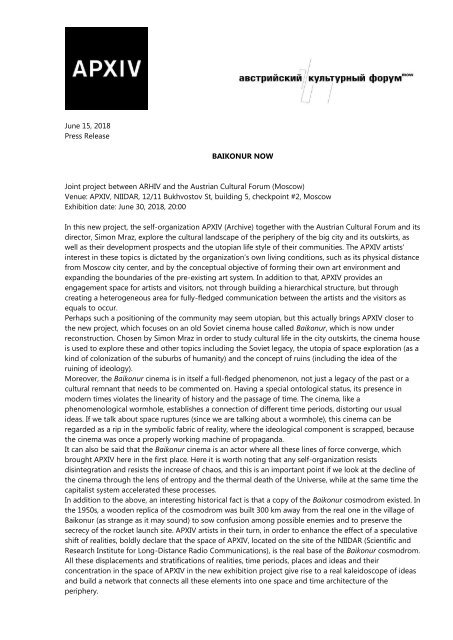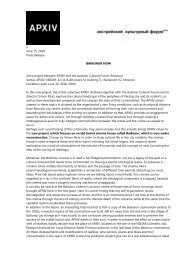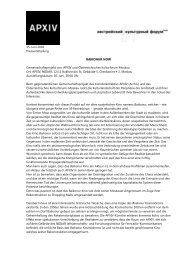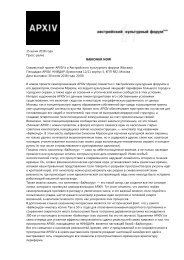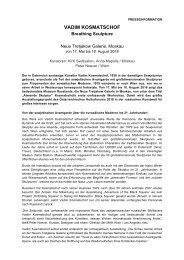RELEASE CINEMAS BAIKONUR EN
You also want an ePaper? Increase the reach of your titles
YUMPU automatically turns print PDFs into web optimized ePapers that Google loves.
June 15, 2018<br />
Press Release<br />
<strong>BAIKONUR</strong> NOW<br />
Joint project between ARHIV and the Austrian Cultural Forum (Moscow)<br />
Venue: APXIV, NIIDAR, 12/11 Bukhvostov St, building 5, checkpoint #2, Moscow<br />
Exhibition date: June 30, 2018, 20:00<br />
In this new project, the self-organization APXIV (Archive) together with the Austrian Cultural Forum and its<br />
director, Simon Mraz, explore the cultural landscape of the periphery of the big city and its outskirts, as<br />
well as their development prospects and the utopian life style of their communities. The APXIV artists'<br />
interest in these topics is dictated by the organization’s own living conditions, such as its physical distance<br />
from Moscow city center, and by the conceptual objective of forming their own art environment and<br />
expanding the boundaries of the pre-existing art system. In addition to that, APXIV provides an<br />
engagement space for artists and visitors, not through building a hierarchical structure, but through<br />
creating a heterogeneous area for fully-fledged communication between the artists and the visitors as<br />
equals to occur.<br />
Perhaps such a positioning of the community may seem utopian, but this actually brings APXIV closer to<br />
the new project, which focuses on an old Soviet cinema house called Baikonur, which is now under<br />
reconstruction. Chosen by Simon Mraz in order to study cultural life in the city outskirts, the cinema house<br />
is used to explore these and other topics including the Soviet legacy, the utopia of space exploration (as a<br />
kind of colonization of the suburbs of humanity) and the concept of ruins (including the idea of the<br />
ruining of ideology).<br />
Moreover, the Baikonur cinema is in itself a full-fledged phenomenon, not just a legacy of the past or a<br />
cultural remnant that needs to be commented on. Having a special ontological status, its presence in<br />
modern times violates the linearity of history and the passage of time. The cinema, like a<br />
phenomenological wormhole, establishes a connection of different time periods, distorting our usual<br />
ideas. If we talk about space ruptures (since we are talking about a wormhole), this cinema can be<br />
regarded as a rip in the symbolic fabric of reality, where the ideological component is scrapped, because<br />
the cinema was once a properly working machine of propaganda.<br />
It can also be said that the Baikonur cinema is an actor where all these lines of force converge, which<br />
brought APXIV here in the first place. Here it is worth noting that any self-organization resists<br />
disintegration and resists the increase of chaos, and this is an important point if we look at the decline of<br />
the cinema through the lens of entropy and the thermal death of the Universe, while at the same time the<br />
capitalist system accelerated these processes.<br />
In addition to the above, an interesting historical fact is that a copy of the Baikonur cosmodrom existed. In<br />
the 1950s, a wooden replica of the cosmodrom was built 300 km away from the real one in the village of<br />
Baikonur (as strange as it may sound) to sow confusion among possible enemies and to preserve the<br />
secrecy of the rocket launch site. APXIV artists in their turn, in order to enhance the effect of a speculative<br />
shift of realities, boldly declare that the space of APXIV, located on the site of the NIIDAR (Scientific and<br />
Research Institute for Long-Distance Radio Communications), is the real base of the Baikonur cosmodrom.<br />
All these displacements and stratifications of realities, time periods, places and ideas and their<br />
concentration in the space of APXIV in the new exhibition project give rise to a real kaleidoscope of ideas<br />
and build a network that connects all these elements into one space and time architecture of the<br />
periphery.
Artists:<br />
Ruslan Polanin<br />
Olga Klimovitskaya<br />
Sofya Ovchinnikova<br />
Katya Granova<br />
Ya Nzi<br />
Vladimir Savostin<br />
Valentin Pirollo<br />
Gosha Golitsyn<br />
Maria Cheloyants<br />
Lika Gomiashvili<br />
Anastasia Soboleva<br />
Nikita Kayem<br />
Anna Kobzeva<br />
ARXIV<br />
https://www.facebook.com/APXIV<br />
apxivgroup@gmail.com<br />
+ 7 926 539 70 72 / Gosha Golitsyn<br />
+ 7 916 667 67 64 / Olga Klimovitskaya<br />
+ 7 977 622 72 40 / Ruslan Polanin<br />
The Austrian Cultural Forum<br />
http://www.akfmo.org/<br />
+7 925 860 12 75 / Simon Mraz, Director<br />
+7 495 7806066 (14) / Daria Gusarova, project manager<br />
Daria.Gusarova@bmeia.gv.at<br />
APXIV is an independent self-organization of artists, created in January 2017, on the territory of the<br />
NIIDAR (Scientific and Research Institute for Long-Distance Radio Communications) in the premises of the<br />
former archive. APXIV was founded to create its own and collaborating with other art environments. In<br />
their works, the artists of APXIV focus on the artistic process and try to get away from the standard<br />
approach to exhibition practices. For example, all exhibitions are held in the format of a one-day event,<br />
and the exhibitions itself is often has a form of a single statement.<br />
The Austrian Cultural Forum in Moscow is the cultural representative office of the Austrian Republic on<br />
the territory of the Russian Federation. The main objective of the Forum is to work with Russian and<br />
Austrian artists in the context of acute and relevant topics. This particular project is part of a bigger<br />
project called "THE PERIPHERY OF THE BIG CITY", the implementation of which is planned in 2018 - 2019.<br />
ATT<strong>EN</strong>TION!<br />
To access the exhibition grounds, please e-mail your full name to apxivgroup@gmail.com<br />
by Friday June 29, 2018 (12.00)<br />
<strong>BAIKONUR</strong> NOW is the first part of a series of artistic projects dealing with a number of 39 historic<br />
cinemas in Moscow living districts. This cultural and historical context of Soviet and urban cultural<br />
institutions is facing fundamental changes. Many cinemas have been closed, and in the near future<br />
they will get a new meaning. Information about upcoming projects with the participation of Yuri<br />
Palmin and Vasilena Gankovska are following soon.


